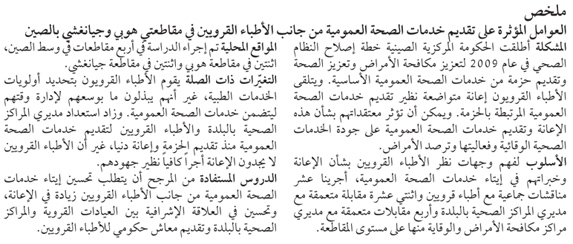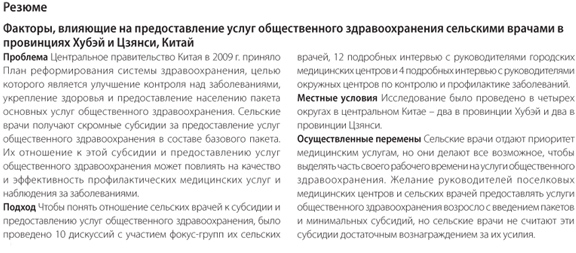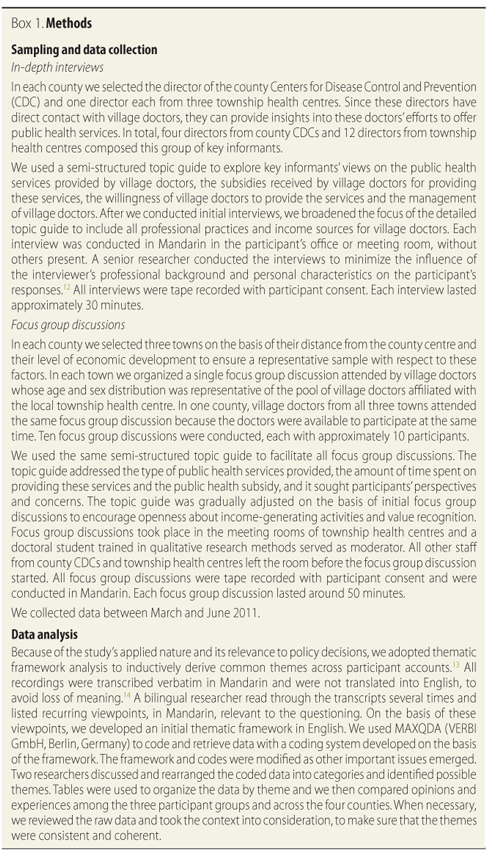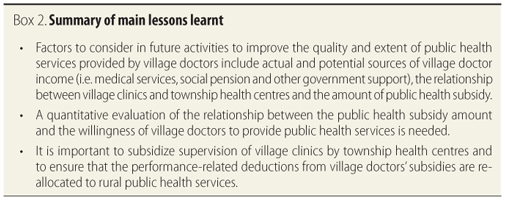LESSONS FROM THE FIELD
Factors influencing the provision of public health services by village doctors in Hubei and Jiangxi provinces, China
Facteurs influant la fourniture de services de santé publique par les médecins de village dans les provinces du Hubei et du Jiangxi, en Chine
Factores que influyen en la prestación de servicios de salud pública por parte de médicos rurales en las provincias de Hubei y Jiangxi, China
Yan DingI; Helen J SmithII; Yang FeiI; Biao XuIII; Shaofa NieIV; Weirong YanV; Vinod K DiwanV; Rainer SauerbornI; Hengjin DongVI,*
IInstitute of Public Health, Heidelberg University, Heidelberg, Germany
IIInternational Health Group, Liverpool School of Tropical Medicine, Liverpool, England
IIISchool of Public Health, Fudan University, Shanghai, China
IVTongji Medical College, Huazhong University of Science and Technology, Wuhan, China
VInstitute for Global Health, Karolinska Institute, Stockholm, Sweden
VICentre for Health Policy Studies, School of Public Health, Zhejiang University School of Medicine, 866 Yuhangtang Road, Hangzhou 310058, China
ABSTRACT
PROBLEM: The Chinese central government launched the Health System Reform Plan in 2009 to strengthen disease control and health promotion and provide a package of basic public health services. Village doctors receive a modest subsidy for providing public health services associated with the package. Their beliefs about this subsidy and providing public health services could influence the quality and effectiveness of preventive health services and disease surveillance.
APPROACH: To understand village doctors'perspectives on the subsidy and their experiences of delivering public health services, we performed 10 focus group discussions with village doctors, 12 in-depth interviews with directors of township health centres and 4 in-depth interviews with directors of county-level Centers for Disease Control and Prevention.
LOCAL SETTING: The study was conducted in four counties in central China, two in Hubei province and two in Jiangxi province.
RELEVANT CHANGES: Village doctors prioritize medical services but they do their best to manage their time to include public health services. The willingness of township health centre directors and village doctors to provide public health services has improved since the introduction of the package and a minimum subsidy, but village doctors do not find the subsidy to be sufficient remuneration for their efforts.
LESSONS LEARNT: Improving the delivery of public health services by village doctors is likely to require an increase in the subsidy, improvement in the supervisory relationship between village clinics and township health centres and the creation of a government pension for village doctors.


RÉSUMÉ
PROBLÈME: Le gouvernement central chinois a lancé le plan de réforme du système de santé en 2009 pour renforcer la lutte contre les maladies et l'amélioration de la santé, et pour fournir un paquet de services de base en termes de santé publique. Les médecins de village reçoivent une subvention modeste pour offrir des services de santé publique liés à ce paquet. Leurs opinions sur cette subvention et la fourniture de services de santé publique pourraient avoir une influence sur la qualité et l'efficacité des services de santé préventive et sur la surveillance des maladies.
APPROCHE: Pour comprendre les perspectives des médecins de village sur la subvention et leur expérience dans le domaine de la fourniture de services de santé publique, nous avons organisé 10 discussions de groupe cible avec des médecins de village, 12 entrevues approfondies avec des directeurs de centres de santé cantonaux et 4 entrevues approfondies avec des directeurs départementaux de centres pour la lutte et la prévention des maladies.
ENVIRONNEMENT LOCAL: Létude a été effectuée dans quatre comtés du centre de la Chine, deux dans la province de Hubei et deux dans la province du Jiangxi.
CHANGEMENTS SIGNIFICATIFS: Les médecins de village donnent la priorité aux services médicaux, mais ils font de leur mieux pour gérer leur temps de manière à inclure les services de santé publique. La volonté des directeurs de centres de santé cantonaux et des médecins de village d'offrir des services de santé publique s'est accrue depuis l'introduction du paquet et d'une subvention minimale, mais les médecins de village ne considèrent pas que cette subvention constitue une rémunération suffisante pour leurs efforts.
LEÇONS TIRÉES: Il est possible que l'amélioration de la fourniture de services de santé publique par les médecins de village nécessite une augmentation de la subvention, l'amélioration de la relation de supervision entre cliniques de village et centres de santé cantonaux et la création d'une pension gouvernementale pour les médecins de village.

RESUMEN
SITUACIÓN: En el año 2009, el gobierno central chino puso en marcha el plan de reforma del sistema sanitario con el objetivo de reforzar el control de las enfermedades y fomentar la salud, así como proporcionar un paquete de servicios básicos de salud pública. Los médicos rurales perciben una modesta subvención por la prestación de los servicios de salud pública relacionados con dicho paquete. Sus opiniones acerca de dicha subvención y la prestación de los servicios de salud pública podrían influir en la calidad y la eficacia de los servicios sanitarios preventivos y de la vigilancia de las enfermedades.
ENFOQUE: Con objeto de comprender los puntos de vista de los médicos rurales acerca de la subvención y sus experiencias en la prestación de servicios sanitarios, hemos llevado a cabo 10 debates con grupos focales de médicos rurales, 12 entrevistas en detalle con directores de centros de salud municipales y 4 entrevistas en detalle con directores de Centros para el Control y Prevención de las Enfermedades provinciales.
MARCO REGIONAL: El estudio se llevó a cabo en cuatro condados del centro de China, dos de ellos en la provincia de Hubei y otros dos en la de Jiangxi.
CAMBIOS IMPORTANTES: Los médicos rurales dan prioridad a los servicios médicos, pero hacen todo lo posible por gestionar su tiempo a fin de incluir los servicios de salud pública. La disposición de los directores de los centros sanitarios municipales y de los médicos rurales para prestar los servicios de salud pública ha aumentado desde la introducción del paquete y de la subvención mínima, si bien los médicos rurales no consideran que sea una retribución suficiente por sus esfuerzos.
LECCIONES APRENDIDAS: Es probable que, para mejorar la prestación de servicios de salud pública por parte de los médicos rurales, sea necesario un aumento de la subvención, una mejora en la relación de supervisión entre las clínicas rurales y los centros de salud municipales, así como la creación de una pensión gubernamental para los médicos rurales.
Introduction
In rural China, health services are delivered through a threetiered system of village clinics, township health centres and county hospitals.1 Village clinics are at the bottom tier, where village doctors serve as patients' first line of contact with the health system.2 Beginning in the 1960s, the Chinese government began a village doctor training programme to create a front-line workforce that provides public health services, such as vaccinations, and basic medical services, such as drugs and outpatient clinical care.3-5 The initial level of training was just a few months but village doctors now must have 2 to 3 years of professional training, equivalent to a high school diploma. Newly appointed village doctors are encouraged to obtain an assistant practicing physician certificate and all village doctors are required to pass an assessment every other year, and a village doctor certification examination every five years to continue practising.5
Local government agencies are required to subsidize village clinics for providing public health services.4 In the last two decades, however, reduced government health spending, together with weak supervision of village doctors by county health bureaus, has undermined preventive health services provision and disease surveillance activities.2,6 Over the same period, marketization of the health sector compelled village doctors to shift their focus to medical services, through which they earn most of their income.3,6 Because of their fee-for-service activities, village doctors are not considered government employees, despite the government's initial role in training this workforce.3,5
The Chinese central government launched the Health System Reform Plan in 2009 to revitalize the provision of basic public health services. Key targets involve improving the ability of the three-tiered system to strengthen disease control and health promotion, as well as providing a package of basic public health services. This package includes establishing health records for all citizens; screening for major diseases for elderly people, women and children; managing chronic non-communicable diseases; providing health education; increasing vaccine coverage for 15 vaccine-preventable diseases; implementing prevention and control programmes for major infectious diseases and geochemical endemic diseases; and ensuring that births occur in hospitals.7,8 To motivate village doctors to provide these preventive services, the government pledged per-person subsidies of 15 renminbi (RMB) for 2009 and 2010, and 25 RMB for 2011.9 Central and local governments are responsible for providing different shares of the subsidy, depending on the region, with the western provinces receiving substantial contributions and the wealthier eastern provinces receiving no contribution from the central government.10
To understand village doctors' perspectives about the subsidy and delivering public health services, we conducted focus groups and interviews with stakeholders in two provinces in central China during 2011. This research was conducted as part of the Integrated Surveillance System in Rural China project, which aims to improve the early detection of epidemics in rural China by integrating syndromic surveillance with the existing case report system.11
Setting and approach
In two counties each in Hubei and Jiangxi provinces, we conducted 10 focus group discussions with village doctors and in-depth one-on-one interviews with key informants comprising directors of township health centres and of county Centers for Disease Control and Prevention (CDCs) during 2011 (Box 1). We focused on village doctors' perspectives on and experiences with the provision of public health services and adopted thematic framework analysis to inductively analyse and interpret the data. Ethics approval for this study was obtained from Heidelberg University, Fudan University and Tongji Medical College.

In 2010, there were 620 700 and 1 021 411 individuals in the Hubei study counties and 317 200 and 383 405 in the Jiangxi study counties. Villages varied in size, from several hundred to approximately 4000 inhabitants. Farming was the predominant occupation among residents. Hubei and Jiangxi ranked thirteenth and fourteenth, respectively, among the 31 Chinese provinces, municipalities and self-governed areas in terms of farmers' average annual income; in the study counties, annual farmer income ranged from 5255 RMB to 6778 RMB (national average, 5919 RMB). Most villages had one clinic but some had more. The typical village clinic had 1 to 3 village doctors, although some clinics had up to 8.
During 2009-2010, approximately 3 RMB of the 15-RMB per-person subsidy were received by village clinics (with the rest shared by county CDCs and township health centres), depending on the number and quality of health records established by affiliated village doctors. In addition, according to province policy, in Jiangxi each village clinic received 300 RMB and each village doctor received 1200 RMB (if they were under the supervision of general township health centres) or 1500 RMB (if they were under the supervision of central township health centres), and in Hubei each clinic received 1000 or 1200 RMB but village doctors received no additional subsidies. Village doctors are entitled to claim other financial support from the government, including reimbursements for clinic construction costs (5000 RMB per clinic in Hubei and 10 000 RMB per clinic in Jiangxi) and new equipment (up to 3000 RMB). Village clinics are, in name, part of the government health system but they are owned by village doctors, who are responsible for profits and losses of the clinics and do not receive the government social pension.
Findings
The public health subsidy for each village doctor is distributed through township health centres on the basis of their assessment of the doctor's performance in providing public health services. Village doctors expressed two concerns about this distribution structure. First, township health centres could impose economic penalties on them for public health work that was not completed or not done well. However, township doctors explained that they were subject to scrutiny from county-level institutions and that withholding subsidies was not a consideration. Second, the use of township health centres as intermediaries in the distribution chain could delay or prevent subsidy receipt. In one county, a township health centre director confirmed that village doctors received no subsidy in 2010 because of local government financial constraints.
The main concern of village doctors appeared to be that providing public health services was time-consuming and limited their ability to perform fee-for-service medical care; the majority acknowledged that policy requirements, rather than other considerations, drove them to provide public health services. The strength of the policy requirements was viewed differently by one township director, who expressed concern that the requirements did not necessarily impact village doctors because they are not employed by the government.
Although some township directors believed that village doctors did not take their public health responsibilities seriously, most key informants asserted that indifference has decreased since the introduction of the subsidy. All village doctors claimed they work hard to implement public health services. Some indicated that they worked at night to complete their public health activities, although they admittedly did so to maintain their fee-based medical service during the day. In one county, the director of the CDC acknowledged that village doctors prioritized providing medical services and that it was therefore common for them to spend time working on public health services at night.
Village doctors frequently mentioned that, despite their contribution to public health, they felt their effort was not valued by the government. One doctor emphasized the importance of feeling valued and how this feeling can influence their willingness to provide services, and village doctors across all four counties indicated a willingness to prioritize public health if they received a more substantial subsidy. Although the subsidy increased in 2011, all study participants considered it insufficient when compared with the amount of work expected of village doctors.
Finally, village doctors noted that, because they contribute a lot to public health but only receive a modest subsidy, have a modest income and lack a pension, they expected the government to include them in a social pension programme and to provide them with a greater than average income. Several township directors remarked on the latter concern by stating that the annual income earned by village doctors from medicines and medical and public health services was already above average (range: 8000-40 000 RMB) and that, for some village doctors, it exceeded the annual earnings of township doctors, who generally have completed 3 to 4 years of college, have an assistant practicing physician certificate and receive a basic salary plus a public health subsidy from the government.
Evaluation and lessons learnt
Box 2 highlights key lessons from this qualitative study. An interesting finding is that although village doctors prioritize medical services for which they can charge, they do their best to deliver preventive services that are part of the basic public health package. They claim that providing public health services involves a significant investment of time that has a negative impact on other income-earning activities. Village doctors also question the extent to which they and their public health work are valued, but some reports indicate that policy-makers hold village doctors and their public health role in high regard.5'7 A possible explanation for this discrepancy is that, because village doctors tend to equate value and recognition with remuneration, they feel undervalued if they consider the subsidy insufficient.

An important question arising from our study is why the government does not make a larger investment in providing public health services through village doctors. One explanation is that the current government strategy is to invest in the demand side of the health system rather than the supply side.5 Another explanation is that, after the severe acute respiratory syndrome epidemic, the government invested heavily in infectious disease control at the expense of other aspects of the public health system.15 Some authors suggest that the central government would like to invest more in village doctors,5 but continued reliance on local governments to fund at least part of the subsidy may limit the amount available for distribution, especially in poor areas, which results in insufficient remuneration and, potentially, substandard quality of public health services.3-5
Supervision of village doctors does not appear to be as effective as it could be. Village doctors complained that the outcome of supervision by township staff sometimes influenced the amount of subsidy they received and township directors mentioned that supervision can be difficult to conduct. Other studies confirmed difficulties in supervising village clinics3,5 and acknowledged that public health services are weak in villages partly because oflimited supervision.3
Our findings suggest that, apart from the financial element of the subsidy, the relationship between village clinics and township health centres is central to improving public health services provided by village doctors. Further research is required to document the relationship between the quality of the public health services provided by village doctors and the level of incentives they receive, to provide an objective metric by which township officials can evaluate the performance of village doctors. It is also important to find ways to re-allocate subsidies deducted from village doctors for poor performance to other rural public health services. Finally, introduction of a pension programme is also an important consideration. There appears to be sufficient political will for this: at the time this study was conducted, the central government started advocating for a pension programme for village doctors.16
In this study, we did not include central or provincial policy-makers among our study participants, nor did we obtain the perspectives of health-care consumers. While our findings are probably generalizable to other provinces in central China, the situation is likely to be different in eastern China, where local governments have the resources to invest more in rural health care, including public health services, compared with western China, where the central government tends to finance a greater proportion of the subsidy. 
Acknowledgements
We are grateful to the study participants in Jiangxi and Hubei province in China, especially CDC staff in the study counties. We also thank Yaqiong Wu, Li Tan, Lu Long, Yi Tian, Qi Zhao, Yipin Zhu and Miao Yu for their help in the field work.
Much of this work was conducted while Hengjin Dong was the junior group leader of Health Economics and Technology Assessment at the Institute of Public Health, Heidelberg University, Heidelberg, Germany.
Yan Ding and Hengjin Dong contributed equally to the study.
Funding: This work was supported by a grant under the European Union Framework Programme 7 (project number 241900).
Competing interests: None declared.
References
1. Meng Q, Yuan J, Jing L, Zhang J. Mobility of primary health care workers in China. Hum Resour Health 2009;7:24. doi:10.1186/1478-4491-7-24 PMID:19292911
2. Liu Y. China's public health-care system: facing the challenges. Bull World Health Organ 2004;82:532-8. PMID:15500285
3. Liu Y, Hsiao WC, Li Q, Liu X, Ren M. Transformation of China's rural health care financing. Soc Sci Med 1995;41:1085-93. doi:10.1016/0277-9536(95)00428-A PMID:8578331
4. State Council of the People's Republic of China. Regulation on the practicing of village doctors. Beijing: SCPRC; 2004. [Chinese]. Available from: http://www. gov.cn/banshi/2005-08/02/content_19251.htm [accessed 2 May 2012] .
5. Bloom G, Kanjilal B, Peters DH. Regulating health care markets in China and India. Health Aff(Millwood) 2008;27:952-63. doi:10.1377/hlthaff.27.4.952 PMID:18607028
6. Bloom G, Xingyuan G. Health sector reform: lessons from China. Soc Sci Med 1997;45:351-60. doi:10.1016/S0277-9536(96)00350-4 PMID:9232730
7. Chen Z. Launch of the health-care reform plan in China. Lancet 2009;373:1322-4. doi:10.1016/S0140-6736(09)60753-4 PMID:19376436
8. State Council of the People's Republic of China. Notice on the publishing of health system reform key implementation plan in recent years (2009-2011). Beijing: SCPRC; 2009. [Chinese]. Available from: http://www.gov.cn/ zwgk/2009-04/07/content_1279256.htm [accessed 2 May 2012] .
9. Notice on the implementation of the public health basic package in 2011. Beijing: Ministry of Health & Ministry of Finance of the People's Republic of China; 2011. [Chinese]. Available from: http://www.moh.gov.cn/publicfiles/business/htmlfiles/mohfybjysqwss/s3578/201105/51781.htm [accessed 2 May 2012] .
10. Yip WC-M, Hsiao WC, Chen W, Hu S, Ma J, Maynard A. Early appraisal of China's huge and complex health-care reforms. Lancet 2012;379:833-42. doi:10.1016/S0140-6736(11)61880-1 PMID:22386036
11. Yan WR, Nie SF, Xu B, Dong HJ, Palm L, Diwan VK. Establishing a web-based integrated surveillance system for early detection of infectious disease epidemic in rural China: a field experimental study. BMC Med Inform Decis Mak 2012;12:4. doi:10.1186/1472-6947-12-4 PMID:22305256
12. Richards H, Emslie C. The 'doctor' or the 'girl from the university'? Considering the influence of professional roles on qualitative interviewing. Fam Pract 2000;17:71-5. doi:10.1093/fampra/17.1.71 PMID:10673494
13. Spencer L, Ritchie J, O'Connor W. Analysis: practices, principles and processes. In: Ritchie J, Lewis J, editors. Qualitative research practice: a guide for social science students and researchers. 1st ed. London: Sage Publications Ltd; 2003. pp. 200-6.
14. Smith HJ, Chen J, Liu X. Language and rigour in qualitative research: problems and principles in analyzing data collected in Mandarin. BMC Med Res Methodol 2008;8:44. doi:10.1186/1471-2288-8-44 PMID:18616812
15. Cyranoski D. SARS triggers biomedical shake-up in China. Nature 2003;425:333. doi:10.1038/425333a PMID:14508448
16. State Council of the People's Republic of China. Suggestions on further enhancing the construction of village doctors. Beijing: SCPRC; 2011. [Chinese] Available from: http://www.gov.cn/zwgk/2011-07/14/content_1906244.htm [accessed 3 October 2012] .
(Submitted: 1 July 2012 - Revised version received: 18 October 2012 - Accepted: 19 October 2012 - Published online: 16 November 2012)
* Correspondence to Hengjin Dong (e-mail: donghj@zju.edu.cn).
